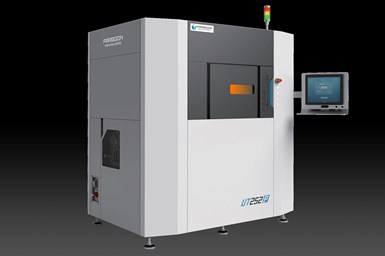Farsoon Develops Ultra Temperature UT252P Plastic LPBF system
The UT252P is based on Farsoon’s 252P laser powder bed fusion system and was developed to offer an even higher chamber temperature capacity for processing materials with high melting points over 340°C.
Farsoon’s UT252P is an ultra temperature configuration with the ability to process materials with high melting points over 340°C. It offers potential for high-temperature applications in material engineering, medical, aerospace and more. As an open platform system, users can process high-performance engineering materials such as PA6, PA66, PPS, PAEK, PI and PTFE for functional applications.
The UT252P is a high-temperature version of the Farsoon’s 252P laser powder bed fusion (LPBF) system which was introduced in 2014 and has been used by a variety of technical research institutes, chemical manufacturers and small-scale production service providers.
The 252P platform’s open platform strategy and temperature capability up to 280°C has supported many chemical manufacturers in specialized engineering materials development. It has also enabled small batch production validation, including PA11, CF, ESD, TPU, PP, PBT, PA6 and PPS, as well as PA66, to expand new industrial applications and markets for additive manufacturing (AM).
To enhance this capability even more, Farsoon created the ultratemperature configuration for the UT252P which offers even higher chamber temperature capacity for processing materials with high melting points over 340°C. It is equipped with a versatile build envelope of 250 × 250 × 320 mm and a powerful 100-W CO2 laser, which can open up new opportunities for high-temperature applications in material engineering, medical, aerospace and more.
The UT252P features an enhanced 8-zone temperature shielding and thermal control, enabling the system to process high-temperature, high-performance engineering materials such as PA6, PA66, PPS, PAEK, PI and PTFE for end-use applications.
With a philosophy of developing truly open platform systems, Farsoon’s polymer application team has been collaborating with multiple material suppliers on material optimization of high-temperature powder material for the LPBF process. Recent success includes sintering one PAEK family material with a high melting point over 340°C, featuring excellent chemical and thermal resistance, low moisture uptake and good fire-resistance as well as and higher wear resistance. During the Beta testing, the parts produced on UT252P featured repeatable results in thermal stability, surface quality and mechanical properties. Meanwhile, with the powder optimization, the material can achieve a low refresh rate with great potential for reduced material cost and true sustainable manufacturing process.
The UT252P ultra temperature system is now open to the global market for beta program applications, as well as material collaboration for high-temperature materials.
Related Content
-
6 Trends in Additive Manufacturing Technology at IMTS 2024
3D printers are getting bigger, faster and smarter. But don’t overlook the other equipment that the AM workflow requires, nor the value of finding the right supplier.
-
Q&A With Align EVP: Why the Invisalign Manufacturer Acquired Cubicure, and the Future of Personalized Orthodontics
Align Technology produces nearly 1 million unique aligner parts per day. Its acquisition of technology supplier Cubicure in January supports demand for 3D printed tooling and direct printed orthodontic devices at mass scale.
-
Concept Sneaker Boasts One-Piece 3D Printed TPU Construction
The Reebok x Botter Concept Sneaker Engineered by HP premiered at Paris Fashion Week, hinting at manufacturing possibilities for the future of footwear.















